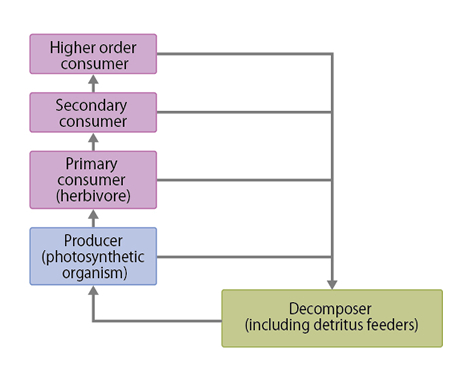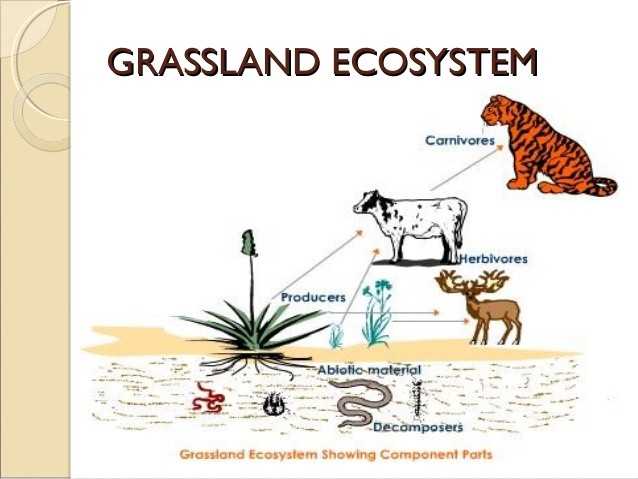Ecosystem
Table of Content |
What is Ecosystem?
 “An Ecosystem is a complex set of relationships among the living resources, habitats and residents of an area. It includes animals, plants, trees, birds, fish, water, soil, micro – organisms and people.”
“An Ecosystem is a complex set of relationships among the living resources, habitats and residents of an area. It includes animals, plants, trees, birds, fish, water, soil, micro – organisms and people.”
In other words, an ecosystem comprise of all the living things in a given area, whereby they interact with each other and their non – living environment (such as soil, climate, water, earth, weather, etc.).
An ecosystem can be huge as it may comprise of different plants and animals, or can be small in particularly harsh places of the world.
Example of Ecosystem
Let us consider an example of puddle which can be shown in the figure below. In it, we can find several living things (such as frog, tadpole, flies, fish and snail) and non – living things (such as sun, water, temperature, weather, humidity, etc.)
Ecosystem Structure
 Ecosystem, at the basic functional level, contains primary producers (i.e. plants) which are capable of harvesting energy via photosynthesis. Next are the consumers and these consumers can be primary consumer (called herbivores) and secondary consumer (called carnivores). Decomposers work at the bottom of food chain. Waste products and dead tissues are produced at every stage of food chain and decomposers not only feed on its energy rather they are also responsible for adding back the organic nutrients.
Ecosystem, at the basic functional level, contains primary producers (i.e. plants) which are capable of harvesting energy via photosynthesis. Next are the consumers and these consumers can be primary consumer (called herbivores) and secondary consumer (called carnivores). Decomposers work at the bottom of food chain. Waste products and dead tissues are produced at every stage of food chain and decomposers not only feed on its energy rather they are also responsible for adding back the organic nutrients.
The diagram given in the right explains the structure of ecosystem along with its different functional level. It includes starting the cycle with producers, followed by primary consumer, secondary consumer and high order consumer. It also includes decomposers who add back the organic nutrients in the environment.
Types of Ecosystem
There are two main types of Ecosystem:
1. Terrestrial Ecosystem – This ecosystem can be found anywhere except heavily saturated places. These are classified into –
-
The Forest Ecosystem – This ecosystem has lot of plants or flora and has large number of organisms in relatively small space. The density of organisms is quite high in this ecosystem and even the small change can affect the entire ecosystem. The forest ecosystem can be further classified into –
-
Tropical Evergreen Ecosystem – It includes tropical forests with the annual rainfall of 80 for every 400 inches. These forests have dense vegetation and comprise of tall trees with different heights. These trees act as the shelter for different types of animals.
-
Tropical deciduous forest – In these forests, dense bushes and shrubs rule along with the trees. These forests have variety of flora and fauna.
-
Temperate evergreen forest – These forests have comparatively lesser number of trees and have ferns and mosses in abundance. Here trees are developed with spiked leaves so as to minimize transpiration.
-
Temperate deciduous forest – These forests are present in moist areas with sufficient rainfall. In these forests, winters and summers are clearly defined and trees shed their leaves in winters.
-
Taiga – Taiga is situated just before arctic region and is defined by evergreen conifers. Taiga is flooded with migratory insects and birds.
-
The Desert Ecosystem – These ecosystems exist in the region with less than 25 annual rainfalls and occupy 17% of the land on earth. Due to high temperature, less rain, intense sunlight, low availability of water, flora and fauna are poorly developed. The leaves and stems here are modified so as to conserve water and therefore, the desert ecosystem mainly comprise of cactus. The animal organisms include camels, reptiles, birds and insects. Following figure illustrates the desert ecosystem. It includes plants at the producer level, followed by primary consumers (such as insects, lizards and rodents); secondary consumers (such as tarantula, scorpion, lizard, snake, etc.) and high order consumers (such as fox, hawk, etc.)
-
The Grassland Ecosystem – This ecosystem is located in temperate and tropical regions of the world. It mainly comprise of shrubs and little number of trees. The main vegetation include legumes, plants and grasses and has lot of grazing animals, along with several herbivores and insectivores insects. The grassland ecosystem is of further two types. Firstly, Savanna, which support large number of grazers and predators and secondly, prairies, which includes short grass prairies, mixed grass and tall grass.The grassland ecosystem is illustrated in the figure given below. In this figure, grazing animals or primary consumers feed on producers and carnivores on these herbivores. Decomposers, too, play an important role in an ecosystem by decomposing the organic nutrients.
-
The Mountain Ecosystem – This ecosystem has diverse array of habitats. The animals in this ecosystem have thick fur coats to prevent from cold and hibernation is commonly found in animals. Low slopes are covered with coniferous forest and at higher altitudes, only treeless alpine vegetation survives.
2. Aquatic Ecosystem – Aquatic ecosystem is found in water and encompasses aquatic flora, fauna and water properties. Aquatic ecosystem are of two types:
-
The Marine Ecosystem – It is the biggest ecosystem that covers around 71% of the surface of earth. Water in marine ecosystem is salty and has high amount of minerals. Several divisions of marine ecosystem are coral reefs, oceanic, profundal, salt marshes, estuaries and hydrothermal vents.
-
The Freshwater ecosystem – In contrast with the marine ecosystem, the freshwater ecosystem is just 0.8% of the earth surface. Three basic kinds of freshwater ecosystem are wetlands, lentic and lotic. This ecosystem comprises of amphibians, reptiles and 41% of the fish species of the world.
Components of Ecosystem
The ecosystem has two main components:
-
Abiotic Components – It includes several physico – chemical or non – living components like water, soil, climate, weather, temperature, humidity, wind, etc. Abiotic components are classified as: Climatic factors, including physical factors like light, temperature, atmosphere, humidity, wind, etc.; Edaphic factors, including structure and composition of soil such as physical and chemical properties – like the type of soil, minerals, soil water, soil profile, soil organisms, etc.; and inorganic substances like carbon, nitrogen, sulphur, water, phosphorus and so on.
-
Biotic Components – It includes living part of the ecosystem such as association of lot of interrelated population, population is different community, etc. Biotic components are further classified as autotrophs (producers), saprotrophs (reducers or decomposers) and heterotrophs (consumers). Following image shows the two main components of ecosystem, i.e. biotic (people, animals and plants) and abiotic components (rocks, water, air, wind, temperature, light, etc.)
Every living being need energy to survive and therefore, every animal do something like running and jumping to use energy. The living beings get energy from food they eat. For example, plants use sunlight, air, water and nutrients from soil to get energy. Thus, energy is mandatory for any living organism to function, grow and survive.
Example of Food Chain
A simple food chain starts with grass, rabbit and fox, where grass is eaten by rabbit and rabbit by foxes.
In another example of food chain, sunlight is being used by producers, i.e. plants. These plants are eaten by primary consumer, i.e. grasshopper. These grasshoppers are being eaten by shrew (i.e. secondary consumer) and finally by an owl (i.e. tertiary consumer). Thus, energy is being transferred from one animal to another via food chain.
Ecosystem services
“Ecosystem services are the benefits provided by ecosystems that contribute to making human life both possible and worth living.”
Example of Ecosystem Services
Ecosystem services consist of products like soil erosion, food and water, disease outbreaks, regulation of floods and several non - material benefits like spiritual and recreational benefits in natural areas. The term services are usually used to focus on tangible and intangible advantages that we obtain from ecosystems.
Some of the Ecosystem Services are as follows:
-
Provisioning services – It includes the products obtained from ecosystem such as food, fiber, genetic resources, fresh water, etc.
-
Regulating services – It includes the advantages of regulating ecosystem processes, such as hazard regulation, climate regulation, regulation of air, water and soil quality, pollination disease and pest regulation, etc.
-
Supporting services – It includes those Ecosystem services which are necessary for the production of all other ecosystem services such as soil formation, primary production, water cycling, nutrient cycling, etc.
-
Cultural services – It includes non – material benefits that we obtain from ecosystem such as recreation and tourism, religious and spiritual enrichment, aesthetic experience, cultural heritage, etc.
The ecosystem services are provided by organizations like Biodiversity Information System for Europe, The Economics of Ecosystems and Biodiversity, etc.
Frequently Asked Questions
Q1. What is flora and fauna?
Sol. Flora and fauna means plants and animals; the word “flora” is used to discuss plant life and “fauna” is referred to animal life. These are just two forms of life that exist in one place.
Q2. What are autotrophs, saprotrophs and heterotrophs?
Sol. The word autotroph is composed of two Greek words, i.e. auto and trophos, where auto means self and trophos means feeder. These are also referred as convertors, producers or transducers. Producers include plants as they carry out photosynthesis, bear chlorophyll and synthesize a high energy organic compound from inorganic raw material using air and sunlight. These are core of all the biotic components.
Added to autotrophs, saprotrophs is also composed of two Greek words, i.e. sapros and trophos, where sapros means rotten and trophos means feeder. These are reducers or decomposers which feed on waste and decaying matter. They absorb a bit of decomposition products so as to provide nourishment.
The word heterotroph is also composed of two Greek words, i.e. heteros and trophs, where heteros mean other and trophs means feeder. This category includes primarily consumers, i.e. animals that feed on other organism. The consumers are further of two type, primary consumers and secondary consumers. Herbivores are the primary or first order consumers as they feed directly on plants such as cattle, rabbit, grass hopper, deer, etc. Carnivores are regarded as secondary consumers as they feed on other animals for their prey. It includes owl, peacock, wolf, etc. The consumers that feed on secondary ones are regarded as tertiary consumers such as lion, tiger, etc.
Q3. What is Ecosystem Approach?
Sol. “The ecosystem approach is a strategy for the integrated management of land, water and living resources that promotes conservation and  sustainable use in an equitable way.” Application of this approach helps in reaching the objectives of Convention. It includes the application of several scientific methodologies on the biological organization which encompass the essential processes, interactions and functions. This approach is considered as the primary framework for the action under Convention. Following figure shows ecosystem approach whereby integrated planning; mitigating options and performance management collectively helps in achieving its objectives.
sustainable use in an equitable way.” Application of this approach helps in reaching the objectives of Convention. It includes the application of several scientific methodologies on the biological organization which encompass the essential processes, interactions and functions. This approach is considered as the primary framework for the action under Convention. Following figure shows ecosystem approach whereby integrated planning; mitigating options and performance management collectively helps in achieving its objectives.
Q4. What is the biome?
Sol. “A biome is a major vegetation type extending over a large area.” The distribution of biome is determined by precipitation and temperature patterns on the surface of the earth.
Watch this Video for more reference





